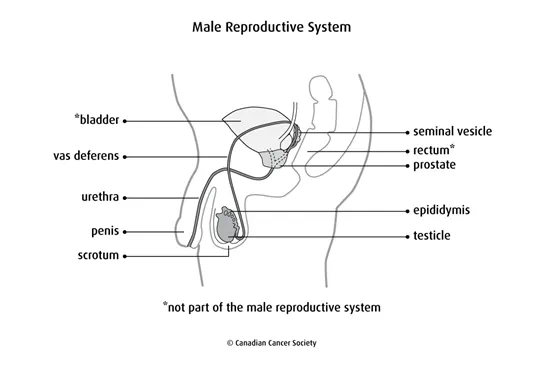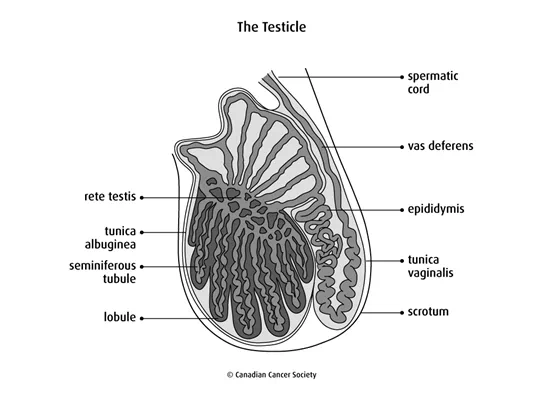The testicles
The testicles (testes) are part of a man’s reproductive system. A man has 2 testicles. Each testicle is egg-shaped and about 5 cm long. The testicles are covered by a sac of skin called the scrotum. The scrotum hangs below the penis, between the legs. The testicles make sperm. They also make testosterone, which is a male sex hormone.

Structure
Each testicle is covered by tough, fibrous layers of tissue called the tunica. The outer layer is called the tunica vaginalis and the inner layer is called the tunica albuginea.
The testicle is divided into parts called lobules. Each lobule contains tiny U-shaped tubes called seminiferous tubules. There are about 800 seminiferous tubules tightly coiled within each testicle.
The seminiferous tubules open into a series of uncoiled, interconnected channels called the rete testis. Ducts, or tubes, connect the rete testis to a tightly coiled tube called the epididymis. The epididymis joins to a long, large duct called the vas deferens.
Each testicle is held in the scrotum by a spermatic cord. Each spermatic cord is made of tough connective tissue and muscle. It contains the vas deferens, blood vessels, lymph vessels and nerves.

What the testicles do
The testicles make sperm and male hormones. The 2 main types of cells in the testicles that perform these functions are germ cells and stromal cells.
Germ cells
The process of making sperm starts in germ cells, which line the seminiferous tubules. As they mature into sperm cells, germ cells move from the lining, through the maze of seminiferous tubules and to the epididymis. The epididymis stores sperm cells so they can completely mature.
Mature sperm cells travel through the vas deferens. Along the way, fluids made by the seminal vesicles and the prostate gland mix with the sperm cells to create semen. The semen is pushed out of the body through the urethra during ejaculation. Sperm in the semen can fertilize a female egg to start a pregnancy.
Stromal cells
Stromal cells help other cells in the testicle. Different types of stromal cells do different things.
Sertoli (nurse) cells are a type of stromal cell found in the seminiferous tubules. They support the germ cells by helping make and transport sperm.
The soft
- sex drive (libido)
- fully developed genitals
- a deep voice
- body and facial hair
- bigger muscles and body size
